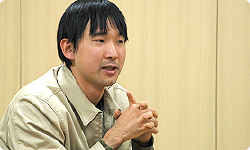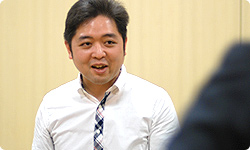2. Short Attention Span? No problem!
Hatakeyama-san, could you please introduce yourself and tell us how you came to be involved with this project?
I’m Hatakeyama. I’m in Production Group 1 of the Software Planning and Development Department with Abe-san. I joined the company in 2006 and the first project I worked on was the Nintendo DS Digital TV Tuner.4When development of that finished and I was wondering what I would work on next, Abe-san came back from development of Smooth Moves. 4Nintendo DS Digital TV Tuner: An adapter that allows the Nintendo DS to receive 1seg data broadcasts available in Japan. The Nintendo DS Digital TV Tuner was never released in Europe.
He said I “came back” because for the final development stages of Smooth Moves I was working over at Intelligent Systems.
When he came back, his seat was right behind mine.
You got involved because you sat near him. (laughs)
(laughs)
I don’t think that was the only reason, though. (laughs) When you sit next to someone, you chat back and forth. When I heard a little about this project, I thought it sounded really interesting. When I was in secondary school I was absorbed in game creation software and made games like shooting games—so much so that I eventually joined Nintendo.

That’s the same as Abe-san! (laughs)
But I’d make about one-third of one stage and…
And then quit.
Yeah.
You even give up quickly like Abe-san! (laughs)
(laughs)
It takes a lot of work to finish a game. Making multiple stages was unthinkable, so I quit. Before that, I was absorbed in Mario Paint.5 When I was in primary school. 5Mario Paint: Tool software for drawing pictures. Released for the Super NES in Europe in December 1992.
You drew pictures with a mouse.
Yes. I wasn’t the type to draw pictures, but for some reason I drew a lot with Mario Paint. I was doing it on the television, and my parents would watch. At the time, I was always playing video games. When I played games like RPGs, they would make disapproving facial expressions. But when I drew with Mario Paint, they would say, “Wow! That’s really good!”
(laughs)
They said maybe I had artistic talent. (laughs) So even if I did Mario Paint until late at night, they wouldn’t get mad.
That’s good. (laughs)
Since I had that background, when I heard we were going to make WarioWare game creation software, I thought it would be great. It has creative elements like drawing pictures and making music, so parents won’t make disapproving faces. What’s more, you just have to make short microgames. (laughs)
Even people with short attention spans can do it. (laughs)
(laughs) Then one day Abe-san asked if I would like to join him, and I said yes..
I see. You got just what you wanted. That brings us to Intelligent Systems’ Sugioka-san, who previously appeared in the session of “Iwata Asks” over WarioWare: Snapped6 How did you become involved, Sugioka-san? 6WarioWare: Snapped!: Distributed as Nintendo DSiWare in Europe from April 2009.
I had heard that after development of Smooth Moves ended, Abe-san was trying to do something new.

You heard it through the grapevine?
Yes. But at the time I was developing the Korean version of WarioWare: Touched!7 Then, about the time work on that ended, Abe-san came and talked to me. 7WarioWare: Touched!: Released for the Nintendo DS in Europe in March 2005.
Did he say, “This is what I want to make. How about it?” and invite you to come on board?
Yeah.
What did you think when you first heard about it?
I thought it was an interesting project. But if we really did make it, I would have to think about all the little details, and I wasn’t sure it could be done.
Abe-san had all these rosy visions in his head, but could they be made a reality?
Exactly.
So Sugioka-san and I, just the two of us, decided to begin with some experiments. We decided to base the drawing part on Mario Paint, and we thought for making music we could do something like lining up music notes. Making the rules of play, though, was the hardest part.

It was nice that you had a model in Mario Paint for drawing pictures and making music, but when it came to what kind of rules the game should have, you didn’t have a previous model, so you needed to try some things out.
Yeah. We decided to call the characters and items that appeared “objects.” We made it so you could make them move, but it was a game, so we needed to make it interactive and easily approachable. We went through a lot of trial and error devising that. Development took a little more than two years, but half of that, about one year, was spent figuring that out.
You were going through a long tunnel. What were you thinking during that time, Sugioka-san?
I was wondering what we could do so the customers in general could easily make microgames. To do that, we decided to divide it up into three large parts. First were the “objects” that Abe-san mentioned. Then there was “background,” which didn’t move, and “sound.” To make these, you would need tools for drawing pictures and creating sound.
So you tackled making a tool for creating the components of microgames.
Yes. But even though we had Mario Paint as a guide, the user interface for the Nintendo DS is quite different, so we went through a process of repeated trial and error, making corrections along the way.
And then it became possible to draw objects and background, and to create sounds. But those components existed separately.
That’s right. To put those components together into one game, we needed to work on construction. So we made something like a test model. When we gave that to one of our designers, he made a microgame in just a few hours. When we saw that, we thought, “This’ll work!” (laughs) After that, we plowed ahead.

Development sped up.
The team was excited. A designer had made it, so we were amazed. We could understand if it had been a programmer. He would know special techniques and be good at thinking things through logically. We were impressed that even a designer could create such a decent game. Then we made about ten microgames. Even at that stage, we thought we would be able to create a satisfying product. Of course, we did add a variety of elements after that, but we had realised it would work and it felt like there was light at the end of the tunnel.
